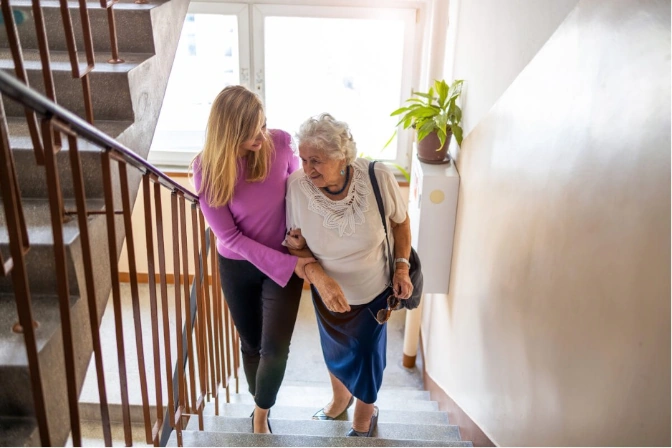Everything to Know About Senior Housing
Everything to Know About Senior Housing: Benefits, Costs, Apartment Options, and More | After55.com

Whether you’re looking for yourself, a parent, or a loved one, finding senior housing can feel overwhelming at times. With so many options available, it can be hard to decide which living arrangement is the best choice. However, with resources like After55, it’s easier to narrow down your options and find the perfect housing for your needs.
In this guide, we’ll explore all things related to senior housing, including the different types, benefits, costs, and more. Here’s a preview of what we’ll cover:
- Senior housing: definition and how it works
- Benefits of senior housing
- Types of senior housing
- Senior housing costs
- Senior housing checklist
What is Senior Housing?
Senior housing is a broad term that refers to residential options for older adults, typically those who are 55 or older. These housing opportunities aren’t your average rental properties. In fact, they’re more so considered communities rather than properties.
Designed to create safe, supportive, and age-appropriate environments for residents, senior housing options often include various features and amenities tailored to the needs of older adults. These can range from grab bars and step-free entryways to socialization starters like golf courses, gyms with group fitness opportunities, and more. The goal is to not only provide a comfortable home for residents but to also create a sense of community that will make their living experience more enjoyable as they age.
Senior housing comes in many different shapes and sizes. Some offerings are built for mobile, independent seniors, while others offer more supervision and assistance. The kind you choose entirely depends on your needs and living preferences. Later in this guide, we’ll explore the different types of senior housing options to help you decide your best fit. But first, let’s explore some of the benefits of senior housing.
Benefits of Living in Senior Housing

Before we explore the different types of senior housing, let’s discuss the benefits. Perhaps you’re living somewhere you’ve called home for years, and you’re not sure if you’re ready to make the jump to senior housing.
While the transition can be daunting, senior housing brings several advantages that enhance the later years of life. Here are a few to highlight:
Low maintenance lifestyle:
One of the biggest benefits of senior housing is the low-maintenance lifestyle it offers. Gone are the days of worrying about upkeeping landscaping or dealing with home repairs. When you embrace senior housing opportunities, all of these responsibilities become a thing of the past, giving you more time for hobbies, relationships, and relaxation.
Though it ranges among properties, many senior housing options include services such as:
- Housekeeping
- Dining services
- Transportation
- Laundry services
- On-site maintenance
Exclusive amenities
Continuing to promote a low-maintenance lifestyle, most senior housing options come with amenities specifically designed for older adults. These amenities often include fitness centers and pools perfect for low-impact training or group classes, social spaces like community rooms, libraries, or game rooms, and more. Certain senior housing may also include all-inclusive rent, 24-hour staff, or on-site healthcare.
Safety and accessibility
Being that some residents might be less mobile than others, senior housing prioritizes safety, security, and peace of mind. Some communities offer security features like 24/7 personnel, emergency response systems, and other safety resources. Additionally, they’ll also feature accessible facilities to mitigate the risk of injuries, such as well-lit pathways, grab bars in bathrooms, and non-slip flooring. These thoughtful additions create a safe and comfortable living environment for residents.
Types of Senior Housing

There are various types of senior housing. However, knowing which is right for you comes down to your unique needs and abilities. For example, mobile seniors who can complete daily tasks on their own will thrive in rental apartments or homes. Meanwhile, those who need some assistance might be better off in an assisted living community.
To determine which type is right for you or your loved one, here’s a breakdown of some senior housing options:
Independent living
Independent living is exactly how it sounds. Offering autonomy and independence to residents, this housing option is fit for adults who don’t require much assistance. Residents can choose from apartments, condos, or houses, often complemented by shared amenities like fitness centers, lounges, and even on-site services such as salons. While fostering independence, these communities also create a close-knit neighborhood atmosphere, offering ample opportunities for social engagement and connection.
Assisted living
Assisted living is much like independent living, only with additional levels of support and aid. These communities have services and staff on-site to help residents with daily activities like bathing, dressing, and cooking meals. Some also offer on-site medical assistance, which can take the form of on-staff nurses or specialty therapists.
This type of living arrangement is ideal for individuals who no longer feel comfortable living entirely on their own but don’t require 24/7 medical supervision. Assisted living serves as an excellent middle ground for seniors navigating the transition between full independence and more intensive care.
Nursing homes
Nursing homes are a step up from assisted living facilities when it comes to medical attention. These communities have on-site doctors, nurses, therapists, and other healthcare professionals to assist residents. Older adults usually choose nursing homes if they have an illness, physical injury or hardship, mental difficulty like dementia or Alzheimer’s, or need rehabilitation after surgery.
Skilled nursing facility
Skilled nursing facilities (SNFs) provide more advanced medical care than nursing homes. Staffed by licensed nurses and healthcare professionals 24/7, these facilities address complex medical needs. SNFs serve individuals needing intensive rehabilitation services like physical, occupational, or speech therapy, often after a hospital stay. They also care for patients managing chronic conditions or recovering from serious illnesses or surgeries. SNF stays are almost always temporary, usually up to about 100 days, whereas nursing home stays are usually much longer or even permanent.
Continuing care retirement communities
A continuing care retirement community, or CRRC, is designed for seniors seeking a long-term living arrangement that can accommodate their changing needs. These communities typically offer varying levels of care, from independent living to assisted living and skilled nursing care. The goal is to assist residents as they age and medical needs change so that they don’t have to relocate for health reasons down the line.
To join a CRRC, residents must sign a contract and pay an entrance fee. Doing so secures them a spot in the community and access to the levels of care offered. The entrance fee can vary greatly depending on the location, services offered, and size of the living space. In addition to the entrance fee, residents also pay monthly fees for maintenance, meals, and other services.
Active adult communities
Active adult communities are similar to independent living facilities but offer greater autonomy and privacy. Unlike independent living, these communities do not provide services like meals, maintenance, or housekeeping. Instead, residents handle these responsibilities themselves. Functioning more like residential neighborhoods, active adult communities allow residents to rent or purchase homes while enjoying shared amenities such as fitness centers, clubhouses, and recreational activities.
Designed for older adults seeking to downsize without compromising an active lifestyle, these communities often have age restrictions, typically requiring residents to be 55 or older. This fosters a close-knit environment where individuals can connect with peers at a similar life stage.
How Much Does Senior Housing Cost?

The price of senior housing can vary depending on the type and size of accommodation, the location of the community, the level of care required, and the length of your stay. For example, assisted living services might cost more than independent living due to their increased level of services. According to the American Health Care Association and the National Center for Assisted Living, the national median rate for assisted living services is $5,350 monthly. However, this cost can vary significantly depending on the state and the accommodations offered.
The method of paying for senior housing can vary. Some seniors may have enough savings to pay for the costs, while others may rely on government programs such as Medicare or Medicaid. It is important for individuals to plan and budget for their future housing needs in order to ensure they can afford their desired living arrangement.
Questions to Ask About Senior Housing
Senior housing encompasses a wide range of options, each offering unique benefits and features. Once you’ve identified the type of housing that suits your needs—whether it’s an independent apartment or a retirement community—it’s important to dig deeper into the details. Here are some key questions to help you evaluate your potential new home:
- Is the community located near essential services like transportation, medical facilities, and shopping centers?
- Does the property appear well-maintained, clean, and inviting?
- How qualified is the staff? What screening and training processes are in place for hiring?
- Are residents actively engaged? How many social activities or events are offered each month?
- How frequently does the menu change, and is the food high-quality and enjoyable?
- Are the common areas well-equipped, appealing, and actively utilized by residents?
- What’s included in the rent, and what is the payment schedule? Is there a grace period for late payments?
- Are family members allowed to visit freely, or is scheduling required?
- Does the facility provide transportation services?
- What do reviews of the community reveal? Are there recurring complaints, and how are they addressed?
- How secure is the community? Are emergency alert systems, like pull cords or buttons, readily available? How does the facility handle medical emergencies?
- Is staff available on-site 24/7?
- Are there restrictions on decorating your space? If the unit is furnished, can personal items be added?
- Are pets allowed? If so, what is the pet policy?
These questions will help you ensure your next home aligns with your lifestyle, priorities, and needs, offering both comfort and peace of mind.
FAQs
How do you qualify for senior apartments?
You generally need to meet the minimum age requirement, typically 55 or older, though some apartments require 62+. Income limits may also apply, especially for low-income housing options. Additional requirements vary by location and property.
Do senior apartments include utilities?
Some senior apartments include utilities like water, electricity, or heating in the monthly rent, while others do not. Always check with the property management for specific details.
Are senior apartments cheaper?
Senior apartments can be more affordable than regular housing, especially if they are subsidized or income-restricted. However, costs vary based on location, amenities, and whether the apartment is market-rate or low-income housing.
How do I apply for senior apartments?
To apply, contact the property management office of the senior apartment you’re interested in. You may need to provide proof of age, income, and other required documentation during the application process.
What is the age for senior housing?
Most senior housing requires residents to be at least 55 or 62 years old, depending on the community. Specific age requirements will vary by property.
Are senior apartments subsidized?
Some senior apartments are subsidized, meaning the government helps cover part of the rent to make it more affordable. These are often available through HUD or local housing programs.